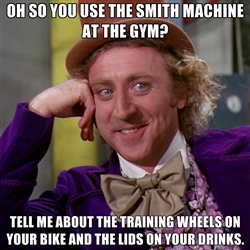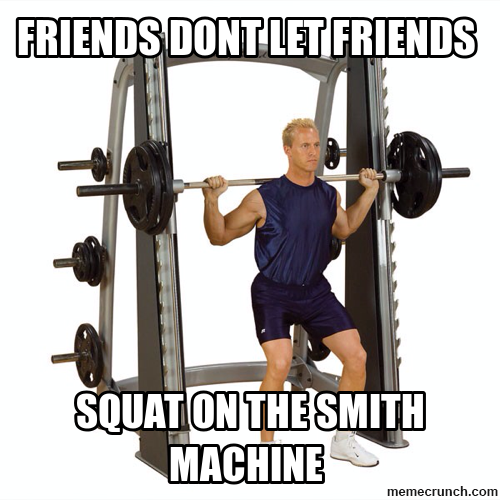The problem with Smith Machines
Every gym has one, no gym needs one. The most over priced hoodie holder in the gym, the Smith Machine was invented in the 1960’s by one of the fathers of modern fitness, Jack Lalanne. Quite possibly one of the few negative thing this fitness colossus did in his career. The intention behind the Smith machine (so named after Rudy Smith, the fitness club executive who mass marketed it) was to create a ‘safe’ way for the masses to have the benefits of free weight squat training without the ‘danger’ of having an unrestrained weight on your back.
The Smith machine is used to squat, shoulder press and bench press. The alleged benefit is that, because the bar just needs to be rotated to lock the bar in place, it creates an extra level of safety and removes the need for spotters and expert tuition.
This is a great idea in theory, but falls down in application.
- You become locked into a two-dimensional plane of movement, which is pretty unnatural.
- Squats (front and back), you can’t achieve a good set up because you can’t apply torsion to the bar.
- Press (Bench and Military), again set up sucks due to lack of torsion and pull over.
You’ll always hear Trainers coach that the bar path on bench and squat should be a straight path, but due to these pesky levers called limbs they rarely are. The abilty to have the bar move slightly outside this 2D plane allows for two benefits. Firstly you find ‘your path’ which is more healthy for you hip and shoulder complexes, especially on the military press where the bar should start just in front of your shoulders and finish directly above them. Secondly this constant readjusting of the bar whilst it is in motion is very good for you. Constantly readjusting trains your small ‘stabiliser muscles’ to fire on and off like guidance thrusters, which has tremendous carry-over to sport and life.
When you are constantly readjusting the bar mid-lift, the safety lock actually becomes a problem and you actual ‘untrain safety’ as you learn to not prang the safety lock against the locking pins. When you move to using real free weights you’ve set yourself up to fail drastically.
To further challenge natural selection, a specialised style of Smith machine squat was devised to tackle some of these issues. But rather than make things better, this method of squatting actually increases the vector load through the knee joints! (Don’t try to second guess natural patterns!)
For those concerned with safety, why not learn the lifts in the correct (and very safe) teaching progression? An example of training safely for the barbell squats would be:
Bodyweight squat with minimal compensation
Power plank (to learn correct tension)
Goblet squat (with dumbell or kettlebell)
Single and double kettlebell front squat (to tidy up asymmetries and hammer in the tension lesson)
Barbell squats (front, back and zercher)
Overhead barbell squats (only if required for athlete and if no compensations)
At each stage, there can be detours to clear up any specific mobility, flexibility or strength issues. For students who have lost mobility in their hips/knees/ankles there are even regressions to the continuum above including elevated heel squats and TRX/Suspension trainer squats. Similar training continuums exist for bench press and military press.
So rather than trying to create new for the sake of new, or as a misguided attempt to improve upon nature, learn to use what nature has given you. Lifting freeweights is natural and has tremendous carry-over to sport and life. Just make sure you enter the continuum at the correct point.
Stay strong, be mobile, have fun!



